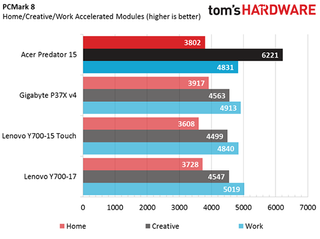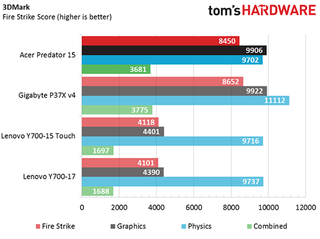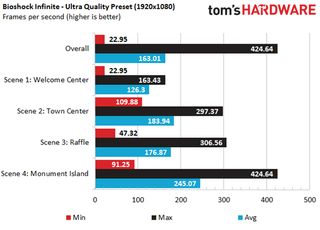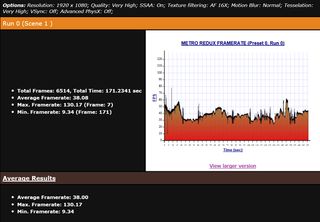Acer Predator 15 Gaming Laptop First Look
Take a hands-on look at Acer's latest response to the growing gaming laptop market: The Predator 15.
Benchmarks And Conclusion
For our first look, we decided to conduct preliminary synthetic and gaming benchmarks to give readers an idea of how the systems run. For this series, our synthetic benchmarks consist of PCMark 8, 3DMark Fire Strike and GFXBench. Gaming benchmarks are conducted with Bioshock Infinite and Metro: Last Light Redux. For comparison, we included our results from the previously reviewed Gigabyte P37X v4. In the comparison, we also included Lenovo's Y700-15 Touch and Y700-17, both of which will receive their own first looks soon.
These are obviously not comparable systems. The GPUs, CPUs, memory and form factors all differ. The P37X v4 is running a fifth-generation Core i7-5700HQ, while the Predator 15 and the two Lenovos are running a Skylake-based Core i7-6700HQ. The P37X v4 and Predator 15 both possess a GeForce GTX 980M, although the Predator 15's 980M only has 4GB of GDDR4. The Broadwell-powered P37X v4 contains 16GB of DDR3 memory. The Predator 15 and the two Lenovos contain DDR4 memory; the two Lenovos contain 16GB of DDR4 memory while the Predator 15 sports a whopping 32GB of DDR4. The Lenovo laptops are both FHD (1920x1080) with IPS panels (15-inch multi-touch for the Y700-15 Touch, and 17.3-inch for the Y700-17). The P37X v4 has a 17.3-inch FHD IPS display.
Again, we're only providing the numbers so you have something to compare to (rather than producing the scores in a vacuum), and we've added a few notes below where those differences impact the scores.
Synthetic Benchmark - PCMark 8

PCMark 8 scores systems based on how well they perform under different workloads. "Home" addresses performance under a fairly light usage model that includes Web browsing. "Creative" addresses more intensive tasks, such as photo editing. Finally, "Work" simulates office performance. All of our PCMark 8 benches run in Accelerated mode.
The Predator 15 exceeds the P37X v4 and Lenovo's systems' Creative scores by a landslide, most likely due to its generous amount of memory. As for Home and Work, the Predator 15's scores are roughly even with the other laptops, give or take a couple hundred points; the differences are negligible.
Synthetic Benchmark - 3DMark Fire Strike

For a more gaming-oriented synthetic benchmark, we use 3DMark Fire Strike. The Predator 15's GTX 980M and i7-6700HQ deliver an impressive score, putting the notebook well ahead of a typical gaming laptop from 2013 and placing it pretty close to the recommended specs for a VR-ready machine.
Both the Predator 15 and P37X v4 contain a GeForce GTX 980M, while the two Lenovos sport 960Ms. Unfortunately, we didn't have a 970M to fold into the results, but as we build up our first looks category, we will see more comprehensive comparisons in the future.
The Predator 15 performed slightly slower than the P37X v4 during the Fire Strike, Graphics and Combined tests, but the differences are negligible for the most part. Most notable is how the Predator 15's Skylake-based processor under-performs the P37X v4's Core i7-5700HQ during the Physics test, which is CPU-heavy; this isn't a mere anomaly, as the two Lenovo laptops perform similarly to the Predator 15 in Physics.
Synthetic Benchmark - GFXBench
We ran all the Graphics tests GFXBench has to offer, including the High-Level, Low-Level, Special and Battery tests. For the High-Level, Low-Level and Special tests, the Predator 15 was plugged into a wall outlet. During the Battery test, the laptop had a fully charged battery. Screen brightness was at 100 percent during all tests.


The Predator 15 performed admirably during the High-Level tests, pulling ahead of both the Lenovo Y700-15 Touch and Y700-17 while rendering on-screen. This can likely be attributed to the stronger GPU and excess memory the Predator 15 has. However, the Predator 15 suffers during the off-screen tests, losing in all but the T-Rex scene. The differences between these results are almost negligible however, and don't necessarily illustrate which system is stronger.



The results for the Tessellation, ALU 2 and Driver Overhead portion of the Low-Level tests both on- and off-screen paint a similar picture. The results are within a hair's width of each other. It isn't until we reach the Texturing test that we see a significant difference in scores, and this can be due to a number of variables, such as the Predator 15's stronger GPU and more RAM.


Finally, the GFXBench Battery tests tell two different stories about the Predator 15 and its battery life. First, the notebook throttles immensely during its battery test. In comparison to the Y700-15 Touch and Y700-17, the Predator 15 rendered an average of 21.6552 frames per second during its slowest run. On the other hand, the Predator 15 achieves substantially longer battery life. We'll take a closer look at this in our in-depth review of the laptop.
Synthetic Benchmark - Unigine Valley

For our Valley Benchmark, we dialed the settings to High Quality at 1920x1080, DirectX 11 and 4x Anti Aliasing. These settings were chosen to stress the Predator 15's graphics subsystem. The 980M dips down to 16.7 FPS on one occasion, but maintains more than 60 FPS for the most part, suggesting that the Predator 15 is adequate for high-end gaming.
Gaming Benchmark - Bioshock Infinite

While benchmarking Bioshock Infinite, settings were dialed to the Ultra quality preset. This isn't a terribly demanding game, and the results show this. There are a few points during the test where the Predator 15 hiccups, but these are few and far between. The average frame rate throughout the benchmark is well above the minimum required for an enjoyable experience. Overall, the Predator 15 demonstrated a minimum frame rate of 22.95, a maximum of 424.64 FPS and an average of 163.01 FPS.
Gaming Benchmark - Metro: Last Light Redux

During Metro: Last Light Redux, the settings were dialed at Very High Quality with SSAA on, Texture Filtering at Anisotropic Filtering 16x, Motion Blur at Normal, Tessellation at Very High and with Vsync and Advanced PhysX off. Metro is not as friendly as Bioshock Infinite, and because of this we chose Metro to illustrate how well a gaming laptop can handle a resource-intensive game. The Predator 15 ran the benchmark scene once, achieving an average frame rate of 38.08. According to the chart, the average remained above 30 FPS for the most part, and rarely dipped below that.
Conclusion
My hands-on experience with the Acer Predator 15 was brief, but enjoyable. This notebook doesn't make any compromises; it offers solid performance in both synthetic and gaming benchmarks, while providing excellent build quality and an ergonomic user experience. Premium performance and quality don't come without a price, however. The Acer Predator 15 G9-591-74KN currently retails for $2,500.
MORE: All Laptops Articles
MORE: Laptops in the Forums
Alexander Quejado is an Associate Contributing Writer for Tom’s Hardware and Tom’s IT Pro. Follow Alexander Quejado on Twitter.
Stay on the Cutting Edge
Join the experts who read Tom's Hardware for the inside track on enthusiast PC tech news — and have for over 25 years. We'll send breaking news and in-depth reviews of CPUs, GPUs, AI, maker hardware and more straight to your inbox.
-
boju Flashy looking thing. In 5 years time you'll see this again from under your bed and you go 'This was the Predator' of my wallet.Reply -
mapesdhs I recently bought an MSI gaming laptop (6700HQ, 970M); oddly, I've found my biggest gripes are to do with practicalities of how various keyboard keys are used, and the lack of customisation options, whereas the raw hw itself is great. Thus, I hope future laptop reviews don't focus too much on performance tests when for daily use I'd say other aspects may actually be more important to a general sense of being satisifed with a product.Reply
EDIT (26/Jan/16): discovered I needed the latest SteelSeries software in order to be able to customise the keyboard (V3.6.3 minimum), so now it works ok, I've changed the keys which were bugging me. Still not quite as flexible as I'd like, but definitely better.
-
voodoochicken My takeaway is that Gigabyte is a MUCH better value, especially for "gaming". And a v5 with Skylake is available that still retails less than the Acer.Reply -
mapesdhs I had a close look at the Gigabyte products, came away unimpressed in the end, though one problem was that a particular model I had been considering just wasn't available anywhere. A manufacturer may have the ideal product, but if it's not available to buy, what's the point? For reference, I bought the MSI GE72 6QF Apache Pro, a customised build imported from a US supplier.Reply
-
f-14 lol at asus for thinking they can get away with charging $2500 for 15.6” Color LCD IPS Monitor (1920x1080) screenReply
fire those marketing guys.
max price is based on screen size and performance 15" max price will be restricted to $1500 or under with 100% top of the line everything to go over that means the battery will never run out EVER like it's wirelessly attached to a nuclear power plant. -
TechyInAZ Honestly, Gigabyte gave me a bad impression with their laptops, I'll buy their mobos and graphics cards in a heart beat, but the first laptop I got from gigabyte (Q2532N) in 2012 wasn't that great. Drivers were not updated frequently at all, and only when absolutely necessary, and both chips hit 95C a ton of the time.Reply -
toddybody 2500...Reply
NO desktop 980 GPU
NO 1440p display (IMO 2160p under 24" is a waste)
ACER build quality
...yeah, I'll take an MSI or ASUS laptop any day of the week over this. -
g-unit1111 Nice specs, but that price... ouch!!! You can get a GS 60 for like $1K less. Thanks but no thanks Acer.Reply -
Quixit Well, I've got to give Acer props for bringing this out. It's a hell of a lot more competitive than their older gaming models, it has an actual 980m and that optional extra cooling fan is an interesting touch. I'd be more likely to buy this than the current ASUS 15" gaming laptop with it's lower GPU and higher weight. I like the Alienware 15 more, but this is a lot better than their last generation and the price is fairly reasonable.Reply -
Argent Gold Reply2500...
NO desktop 980 GPU
NO 1440p display (IMO 2160p under 24" is a waste)
ACER build quality
...yeah, I'll take an MSI or ASUS laptop any day of the week over this.Nice specs, but that price... ouch!!! You can get a GS 60 for like $1K less. Thanks but no thanks Acer.
Thanks for the feedback everyone. It really helps! My full price analysis (including different configurations of the Predator 15 and the larger Predator 17) is going to be included in our full review.
Honestly though, I agree with you all in terms of price, but remember that $2500 is the price for the configuration we received. There are cheaper models of the Predator 15 retailing for closer to $2000, give or take $100. That isn't too bad, and you'd be hard pressed to find a laptop with a GTX 980M and a Skylake processor retailing for any less than that. I could name more than a handful. At the $2000 sweet spot, you'll be trading blows with every other laptop vendor at that price point, and I believe that a Predator 15 that better matched those specs would do well in this category. If Skylake isn't that important to you, you can definitely find something a lot cheaper than ~$2000 with a 980M.
As for build quality, I didn't expect much either. I've used laptops of all sorts, from desktop replacements to ultrabooks, and from all varieties of laptop brands. Acer's lower end laptops might not be up to par compared to other offerings, which is why I was surprised when I got to use the Predator. It's really good. It's even better than some Asus and MSI laptops I've played with.
As for a desktop 980, I'm afraid that you can't find one for around $2500. A barebones gaming laptop with a desktop 980 would cost at least a few hundred dollars more.
Once again, thanks for the input. It really helps!
-Alex
